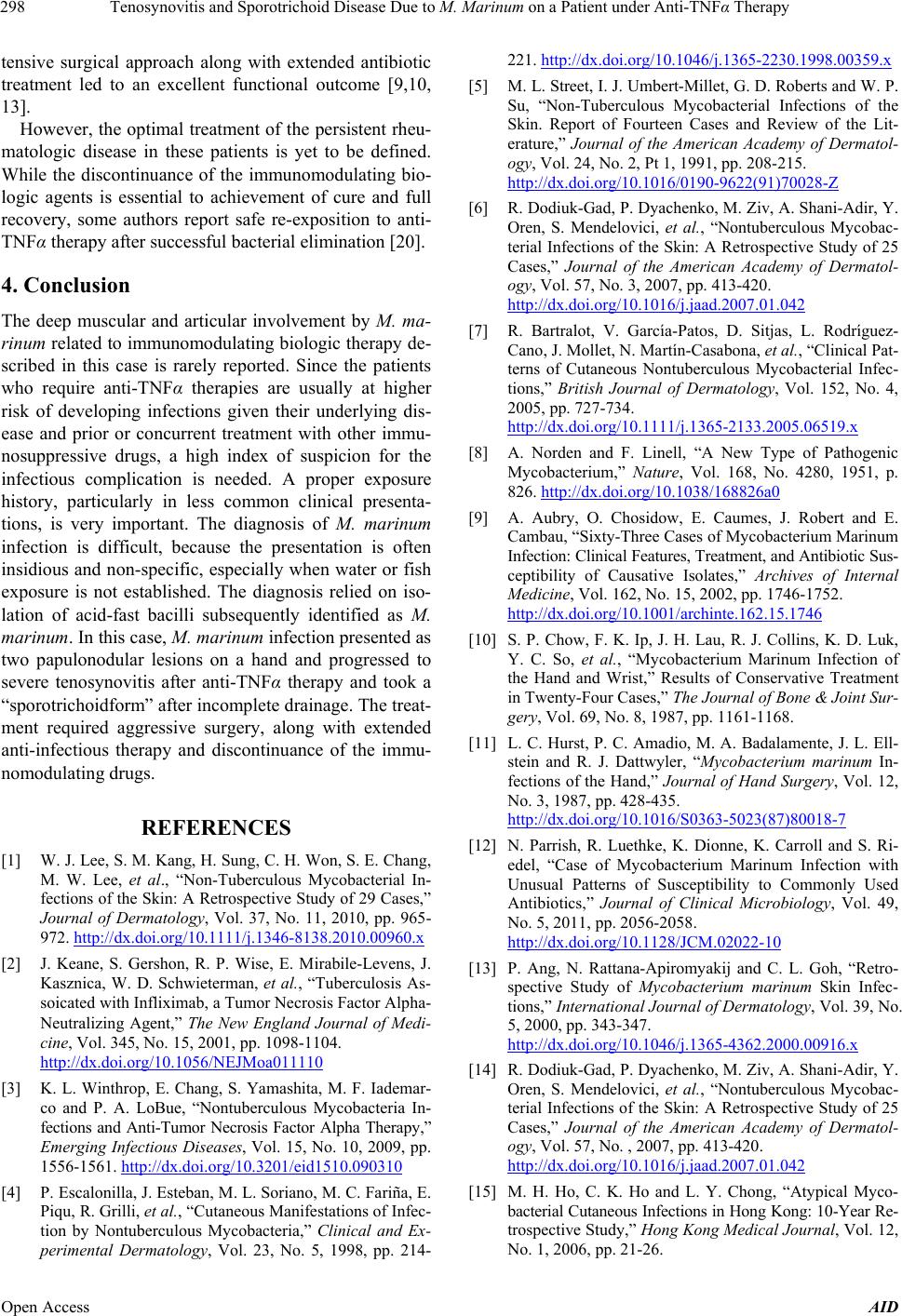
Tenosynovitis and Sporotrichoid Disease Due to M. Marinum on a Patient under Anti-TNFα Therapy
298
tensive surgical approach along with extended antibiotic
treatment led to an excellent functional outcome [9,10,
13].
However, the optimal treatment of the persistent rheu-
matologic disease in these patients is yet to be defined.
While the discontinuance of the immunomodulating bio-
logic agents is essential to achievement of cure and full
recovery, some authors report safe re-exposition to anti-
TNFα therapy after successful bacterial elimination [20].
4. Conclusion
The deep muscular and articular involvement by M. ma-
rinum related to immunomodulating biologic therapy de-
scribed in this case is rarely reported. Since the patients
who require anti-TNFα therapies are usually at higher
risk of developing infections given their underlying dis-
ease and prior or concurrent treatment with other immu-
nosuppressive drugs, a high index of suspicion for the
infectious complication is needed. A proper exposure
history, particularly in less common clinical presenta-
tions, is very important. The diagnosis of M. marinum
infection is difficult, because the presentation is often
insidious and non-specific, especially when water or fish
exposure is not established. The diagnosis relied on iso-
lation of acid-fast bacilli subsequently identified as M.
marinum. In this case, M. marinum infection presented as
two papulonodular lesions on a hand and progressed to
severe tenosynovitis after anti-TNFα therapy and took a
“sporotrichoidform” after incomplete drainage. The treat-
ment required aggressive surgery, along with extended
anti-infectious therapy and discontinuance of the immu-
nomodulating drugs.
REFERENCES
[1] W. J. Lee, S. M. Kang, H. Sung, C. H. Won, S. E. Chang,
M. W. Lee, et al., “Non-Tuberculous Mycobacterial In-
fections of the Skin: A Retrospective Study of 29 Cases,”
Journal of Dermatology, Vol. 37, No. 11, 2010, pp. 965-
972. http://dx.doi.org/10.1111/j.1346-8138.2010.00960.x
[2] J. Keane, S. Gershon, R. P. Wise, E. Mirabile-Levens, J.
Kasznica, W. D. Schwieterman, et al., “Tuberculosis As-
soicated with Infliximab, a Tumor Necrosis Factor Alpha-
Neutralizing Agent,” The New England Journal of Medi-
cine, Vol. 345, No. 15, 2001, pp. 1098-1104.
http://dx.doi.org/10.1056/NEJMoa011110
[3] K. L. Winthrop, E. Chang, S. Yamashita, M. F. Iademar-
co and P. A. LoBue, “Nontuberculous Mycobacteria In-
fections and Anti-Tumor Necrosis Factor Alpha Therapy,”
Emerging Infectious Diseases, Vol. 15, No. 10, 2009, pp.
1556-1561. http://dx.doi.org/10.3201/eid1510.090310
[4] P. Escalonilla, J. Esteban, M. L. Soriano, M. C. Fariña, E.
Piqu, R. Grilli, et al., “Cutaneous Manifestations of Infec-
tion by Nontuberculous Mycobacteria,” Clinical and Ex-
perimental Dermatology, Vol. 23, No. 5, 1998, pp. 214-
221. http://dx.doi.org/10.1046/j.1365-2230.1998.00359.x
[5] M. L. Street, I. J. Umbert-Millet, G. D. Roberts and W. P.
Su, “Non-Tuberculous Mycobacterial Infections of the
Skin. Report of Fourteen Cases and Review of the Lit-
erature,” Journal of the American Academy of Dermatol-
ogy, Vol. 24, No. 2, Pt 1, 1991, pp. 208-215.
http://dx.doi.org/10.1016/0190-9622(91)70028-Z
[6] R. Dodiuk-Gad, P. Dyachenko, M. Ziv, A. Shani-Adir, Y.
Oren, S. Mendelovici, et al., “Nontuberculous Mycobac-
terial Infections of the Skin: A Retrospective Study of 25
Cases,” Journal of the American Academy of Dermatol-
ogy, Vol. 57, No. 3, 2007, pp. 413-420.
http://dx.doi.org/10.1016/j.jaad.2007.01.042
[7] R. Bartralot, V. García-Patos, D. Sitjas, L. Rodríguez-
Cano, J. Mollet, N. Martín-Casabona, et al., “Clinical Pat-
terns of Cutaneous Nontuberculous Mycobacterial Infec-
tions,” British Journal of Dermatology, Vol. 152, No. 4,
2005, pp. 727-734.
http://dx.doi.org/10.1111/j.1365-2133.2005.06519.x
[8] A. Norden and F. Linell, “A New Type of Pathogenic
Mycobacterium,” Nature, Vol. 168, No. 4280, 1951, p.
826. http://dx.doi.org/10.1038/168826a0
[9] A. Aubry, O. Chosidow, E. Caumes, J. Robert and E.
Cambau, “Sixty-Three Cases of Mycobacterium Marinum
Infection: Clinical Features, Treatment, and Antibiotic Sus-
ceptibility of Causative Isolates,” Archives of Internal
Medicine, Vol. 162, No. 15, 2002, pp. 1746-1752.
http://dx.doi.org/10.1001/archinte.162.15.1746
[10] S. P. Chow, F. K. Ip, J. H. Lau, R. J. Collins, K. D. Luk,
Y. C. So, et al., “Mycobacterium Marinum Infection of
the Hand and Wrist,” Results of Conservative Treatment
in Twenty-Four Cases,” The Journal of Bone & Joint Sur-
gery, Vol. 69, No. 8, 1987, pp. 1161-1168.
[11] L. C. Hurst, P. C. Amadio, M. A. Badalamente, J. L. Ell-
stein and R. J. Dattwyler, “Mycobacterium marinum In-
fections of the Hand,” Journal of Hand Surgery, Vol. 12,
No. 3, 1987, pp. 428-435.
http://dx.doi.org/10.1016/S0363-5023(87)80018-7
[12] N. Parrish, R. Luethke, K. Dionne, K. Carroll and S. Ri-
edel, “Case of Mycobacterium Marinum Infection with
Unusual Patterns of Susceptibility to Commonly Used
Antibiotics,” Journal of Clinical Microbiology, Vol. 49,
No. 5, 2011, pp. 2056-2058.
http://dx.doi.org/10.1128/JCM.02022-10
[13] P. Ang, N. Rattana-Apiromyakij and C. L. Goh, “Retro-
spective Study of Mycobacterium marinum Skin Infec-
tions,” International Journal of Dermatology, Vol. 39, No.
5, 2000, pp. 343-347.
http://dx.doi.org/10.1046/j.1365-4362.2000.00916.x
[14] R. Dodiuk-Gad, P. Dyachenko, M. Ziv, A. Shani-Adir, Y.
Oren, S. Mendelovici, et al., “Nontuberculous Mycobac-
terial Infections of the Skin: A Retrospective Study of 25
Cases,” Journal of the American Academy of Dermatol-
ogy, Vol. 57, No. , 2007, pp. 413-420.
http://dx.doi.org/10.1016/j.jaad.2007.01.042
[15] M. H. Ho, C. K. Ho and L. Y. Chong, “Atypical Myco-
bacterial Cutaneous Infections in Hong Kong: 10-Year Re-
trospective Study,” Hong Kong Medical Journal, Vol. 12,
No. 1, 2006, pp. 21-26.
Open Access AID